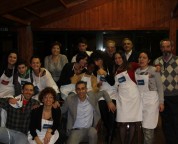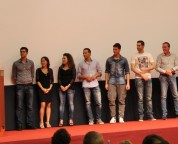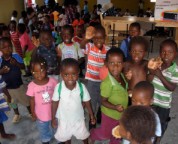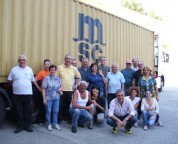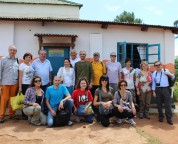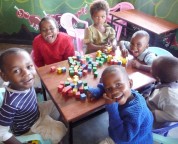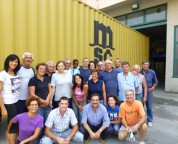ZAMBIA: Angelo’sVillage
Angelo’s Village is the result of the efforts of the Forcellini family, Marino and Tosca, in memory of their son, and of their collaboration with the charity association “Noi per Zambia”, starting from 1999. The village consists of one elementary school, where every day 1,100 children receive regular education. Over time other structures were built including a feeding center, where children have a daily free meal, a health center and many dwellings for teachers and the poorest families. The construction of an hospital will start soon.
MALAWI:
Malawi is one of the twelve least developed countries in the world. 65% of its population lives on less than 1 dollar a day. Around half of national income comes from development aid. San Marino for the Children has promoted the following projects in Malawi:
- Kindergarten in Matola
Our attention was focused in 2009 on Matola, an area with basic needs, hosting a very large number of people in extreme poverty.
Matola is a village located on the outskirts of Balaka, 7 kilometres from the city centre.
Being close to the city centre, Matola is densely populated and it is a transit area for many people commuting every day from the surrounding rural areas to Balaka, where the main activities of the whole district and the most important and essential public facilities (e.g., hospital, drugs and food dispensary etc.) are located.
Based on our experience, we planned to direct aid in a precise area, according to accessibility, necessity and populousness criteria, in order to ensure that the projects undertaken can be an engine for the development and a source of aid for the villages and the surrounding areas. For this reason “San Marino for the Children” bought a few hectares of land in Matola and started in 2009 the first project, building a kindergarten and, later, other service facilities for the common good of the village.
The works lasted two years; in 2012 the facility was open to the public, providing food and care to about 250 children.
The kindergarten is composed of six rooms, one canteen, one hall, offices and services. It was built with innovative materials (roofs are made with special material sent from Italy that prevents overheating and maintains the envisaged temperature conditions of the building), big and colourful rooms for the harmonious development of every child. Primary beneficiaries of this project are pre-school children (aged 2 to 6 years).
The kindergarten in Matola, and in general kindergartens in Africa, has a primary role for:
-NUTRITION: statistics show that most of the deaths of preschool children (0-6 years) in Malawi (one of the highest death toll in the world) are caused by starvation/malnutrition and gastrointestinal infections due to several nutritional problems. Missionary kindergartens (Malawi school system does not include state kindergartens) are also aimed at providing children with a daily meal.
– SOCIAL AND HEALTH CARE: Malawi counts over a million orphans, often living in extended families where adults do not always provide them with supervision and assistance. Moreover “street children” remain a widespread phenomenon, that is young children experiencing homelessness and living on the streets. Kindergartens offer custody and supervision, good sanitary and health conditions that can prevent the spread of infections, diseases and injuries.
-EDUCATION: Kindergarten is of fundamental importance in the development and spread of education. Children are given access to primary knowledge, facilitating and speeding up the learning of subjects in primary schools, thus giving them a better chance of completing their study.
These are the reasons why the Association is operating in Malawi.
In matola we also realized a family home for orphans and a mill.
- Fountain and mill in Matola
In 2012, we also built a fountain in Matola (Malawi), in order to improve access to water for the people of the village, and a mill to favor the grinding of corn cobs and consequently its cultivation.
- Reception centre for orphans in Matola
This centre built in Matola near the structures mentioned above and funded by Ceramiche di Faetano was finished in October 2012. The reception center, run by a local family, hosts very small orphans (in Malawi there are more than one million small orphans), who receive affection, assistance for their basic needs and the warmth and protection of a home. This activity is carried out thanks to the missionary nuns in Malawi and to San Marino for the Children.
- Support to the nursery school inside the prison in Zomba
Monfort Fathers set up a nursery school inside Zomba prison for children who previously used to live their entire childhood in the cells with their mothers. San Marino for the Children and FONDAZIONE SIMONCINI decided to support this project in 2013. In particular, this kindergarten provides daily education and meals to all children living in the structure. Moreover, additional food, soap and medicines are given to all children of imprisoned women in order to improve the quality of their life and ensure a healthy physical and mental growth.
“Tikondane” kindergarten, that means “Let us love” in the Chicewa language, is located at the Zomba prison.This prison was built in 1905.
The non-profit organization “San Marino for the Children” in early 2013 decided to join the project and support the prison kindergarten, by providing furniture, teaching materials and adequate nutrition for children, thus “adopting” Tikondane in order to help female prisoners raising their children.
The situation in Tikondane kindergarten is serious and children living with their mother, because no other family member can care of them outside the prison, pay the price for it: no special treatment is granted for them; same food every day (polenta with beans and some vegetables) as for adults; meat only twice a year.
Children can live with the mother until the age of five and then, in case of longer penalty or life-sentence, children are removed from their mother. Sometimes children are born in prison and they are held there for the first years of their life.
They sleep crammed in dirty rooms, closed from 3.30 p.m. to 5.30 a.m. with no toilet; they have to use can for their physiological needs.
Medical assistance and treatment are insufficient. Because of their physical prostration, prisoners are vulnerable to infections and contagious diseases.
Maintaining a good level of personal hygiene is difficult because there is no soap. Living in prison leads to outbursts and acts of violence or to lethargy and loss of personal identity.
For this reason a charity project called “Happy Island” was launched, thanks to the collaboration of Father Pergiorgio Gamba, an Italian missionary who has been living in Malawi for thirty years. Father Gamba is Inspector of prisons in Malawi and co-drafter of the annual report to the Parliament; he is also an on-site project manager, organizing activities of development and social justice in prisons. “Happy Island” means a place where to play, learn and have a proper diet. A kindergarten was built within the perimeters of the prison to accommodate the prisoners’ children. Therefore children can exit from cells (while remaining within the prison perimeter) and spend the day in a healthier environment, more suitable for the growth of a child.
This kindergarten is also attended by the prison guards’ children, for a better success of the project.
- Primary school on Chikala mountain
The building of Chikala primary school started on 19 September, 2013. This project has been funded by DEL CONCA Group (composed of Ceramica Faetan oLtd., Ceramica Del Conca Ltd. and Pastorelli Ltd.), in collaboration with San Marino for the Children.The town is not connected with roads and can only be reached after a 2 hour long walk on a narrow path. This is impossible especially for children who, as a result, are excluded from social life. In September 2014, the school was inaugurated thanks to Del Conca Group’s support. At present, there are three structures with a total of eight classrooms attended by 300 students from Chikala town.
Mount CHIKALA rises near Mount Chaone, in southern Malawi, 50 Km from Zomba. The village located on the top of the mountain has no connecting roads for vehicles; the only way that leads to the nearest city centre is a very hard and steep trial.
The nearest city with a hospital is Malosa, 10 km away from CHIKALA mountain. Near the mountains lies the large marsh of Lake CHIRWA, bordering Mozambique.
Chaone and Chikala mountains host a large population because on the plateau at the top of the mountain year-round streams flow. A good agricultural policy can help transforming these plateaus in vegetable gardens.
Over 100 families live on the top of Mount Chikala, that is a population of a few thousand people. Saving this mountain is essential to prevent this population from moving in the slums of big cities.
Life is tough in such an isolated village, without even a connecting road; no electricity is available (wood stove) and the water well was dug by hand (a hand pump helps obtaining clean water so as to avoid cholera coming from the swamp below).
The Monfort missionaries friars started developing the village by building the Church; women brought the water from the stream and young people carried with their arms supplies from the valley to the village walking on the trail.
The successful construction of the Church paved the way for the construction of the school, in cooperation with the people of the village.
School was an antidote to degradation that could have lead young people to leave the mountain.
The only schools were located downstream, near the swamp, one hour and a half from the village. Hardly anyone could complete their primary education, because the trial was too hard, especially for young children. Children could start going to school on their own at the age of 10, but entering into school at 10 years old was definitely disproportionate. Without compulsory education in Malawi, only highly motivated parents could accompany their children to school.
For this reason, few children from the mountain went to school: girls never completed their education (because they got married at the age of 15 years) and boys left school because they thought all that effort was useless (in the village they were considered as lazy people because they did not go to work in the fields and too old for school compared to the other schoolmates).
The waste of time and energy was invaluable. But, above all, the lack of education in the village blocked the evolution of the whole community.
At least 400 school-age children live on the mountain.
In September 2013, during a visit in Malawi, some friends of the Association visited Mount Chikala; Father Gamba had informed us on the issue of the lack of school opportunities for this population.
We climbed the mountain to reach the village. Some villagers join us along the trail. The rest of the community welcomed us in the church, where they organized a beautiful party with songs and dances. Then the first stone was laid. We were aware of the enormous difficulties of this project but the challenge was exciting.
The project on Mount Chikala included the construction of a primary school with 8 classrooms and an office for teachers and the principal, divided into three blocks of buildings with outdoor bathrooms for boys and girls. Next to the school, the Malawian Ministry of Education required the construction of two houses for the teachers sent by the Ministry to start the school.
We went back to Chikala on 22 September 2014, one year after the beginning of the works, to inaugurate the new school of the village, that now hosts 300 children. This marked the beginning of a new story for this village, which now can offer to its young people education and new possibilities for their future.
- Restructuring and extension of the primary school in Kankao village
Kankao Primary School is composed of several buildings hosting 1504 students.
The number of students enrolled was well above the school capacity (some classrooms accommodate more than 130 students, but the maximum number should be 70). Over the years the structure has served less and less the purpose of teaching because of the lack of maintenance and renovation.
The growing number of students and the cracks in the walls had made this structure no longer appropriate its function.
Our plan was to refurbish this school, restoring its structure to serve the principles and objectives that had motivated the missionaries to build it, in order to give to many young people living in the surrounding villages the chance to create a better future for themselves.
Following our inspection at Kankao Mission in September 2014, we found the urgent need to refurbish the primary school in the village.
Kankao village was one of the first (and poorest) rural villages where the Montfort missionary congregation was established over fifty years ago.
This centre covers an area of 110 villages and serves about 24,000 people. Next to the Montfort missionary friars, the village also hosts the missionary sisters of the Palazzolo Institute from Bergamo, who devote their lives to orphans, disabled children and provide medical care in the hospital they built there.
The Mission – that helps the outcasts of this area – was established in Kankao many years ago and one of the first structures built was the primary school.
The most urgent intervention in the school was to repair the building; serious cracks and consequent misalignment of the perimeter and retaining walls were endangering the safety of students and teachers as these structures were at risk of collapsing.
In order to restore security and functionality, three wings of the building were demolished and rebuilt. Indeed, these three wing were the first to be built over 50 years ago by the Montfort missionaries and have become unsafe and not repairable.
Given the huge population growth in Malawi we designed a larger structure and more classrooms.
As in most primary and secondary schools in Malawi, classrooms do not have desks and chairs, pupils must therefore sit on the ground. The situations of the classrooms was not for good conditions of learning.
Our initiative provided desks and chairs (benches) for more effective conditions of learning and for a healthier school. We realized our purpose to create better conditions in order to give to 1504 young lives new chances for their future ; we went back to Kankao on April 2016 to inaugurate the new school of the village, that now hosts 1600 children. This marked the beginning of a new story for this new school in Kankao , which now can offer to its young people education and new possibilities for their future.
- Restructuring and extension of the primary school in Balaka village
At the origin of this new project “Saint Augustine School – Graziani Foundation” there is all the experience that San Marino for the Children has gained in the reconstruction of the primary school of Kankao.
Precisely the new project “Saint Augustine School – Foundation Graziani ” is starting on the positive experience at Kankao .
The Saint Augustine Full Primary School is on the road from Balaka to Kankao; this school has had a good start but now is literally stifled by the too large number of students. The volunteers of the San Marino Association for the Children know well this school that is located right along the connecting road between Balaka and Kankao.
At present Saint Augustine School is in a dilapidated condition and without any kind of dignity for its two thousand students; is a perilous structure where shortage of maintenance and inadequate structures really make these structure gloomy and unhealthy spaces. Inside the school is too dark, no windows, no benches and chairs makes all as a punishment.Although the school material is almost absent.
The benefits of helping the Saint Augustine school are linked to a school structure already approved and recognized by the Ministry of Education; there are already two thousand students wishing to learn, there are teachers already enrolled for this school.
The project will be similar to previous experience; eight classrooms divided into two blocks of four classrooms (classrooms that will be very spacious, with a 9×9 meter dimension). It will be 36 meters long for 12 meters wide for each block of classrooms.
At the center of the two class blocks will be a library and additional classrooms with sufficient space for all students. Works are started in August 2017 and we will finish the summer of 2019.
The right to study is one of the fundamental and inalienable rights of the person, is in the Universal Declaration of Human Rights of the United Nations.
The concrete possibility of realizing this right to education – especially for girls, the future mothers of Malawi – is a fundamental step because knowledge represent the beginning of full freedom, of autonomy and hope for a better future.
It is in the short term the best chance of growing new generations, not only the present but also the future generations.





